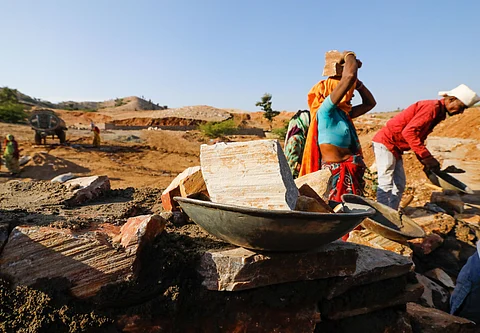

Capping expenditure under the Mahatma Gandhi National Rural Employment Guarantee Scheme (MGNREGS) will have adverse effects on tribal populations and undermine rural employment generation across India, experts have warned.
Earlier this month, the Union government imposed a cap of 60 per cent on MGNREGS spending for the first six months of the 2025-26 financial year. The scheme has been allocated a total budget of Rs 86,000 crore for the year.
Tribal communities rely heavily on the scheme, especially between April and June, the lean agricultural season, according to Chakradhar Buddha, a researcher with LibTech India — a collective of engineers, social scientists and activists working to improve public service delivery.
“For instance, in Alluri Sitharama Raju district of Andhra Pradesh, where over 80 per cent of the population is tribal, more than 55 per cent of annual MGNREGS work is generated in just these three months,” he said.
Regions with large tribal populations, drought-prone areas and economically vulnerable households are particularly dependent on early-season employment under the scheme. Curtailing funds during this period would push families into deeper precarity and undermine already fragile rural livelihoods, Buddha warned.
Nearly 20 per cent of the first half’s budget typically goes towards clearing pending wage arrears from the previous financial year, rather than generating fresh employment, he added. This creates an acute shortage of funds for new demand, effectively defeating the rationale behind the cap.
Only 6.32 per cent of total annual person-days were generated in this period over the last three years, according to the government’s Management Information System (MIS).
Experts have also argued that the cap contradicts the spirit of the legal mandate of MGNREGS, which guarantees employment on demand.
The spending cap would likely compel states to deny work even when genuine demand exists — rendering the right to employment under Section 3 of the Act virtually unenforceable, Purbayan Chakraborty, from the trade union Paschim Banga Khet Majoor Samity. Chakraborty has earlier raised issues regarding MGNREGS workers in West Bengal.
“It may also lead to a situation where workers are compelled to continue without receiving payments within the statutorily prescribed time limit,” he said.
Laavanya Tamang, a senior research associate at the Foundation for Responsive Governance and affiliated with NREGA Sangharsh Morcha, added that the scheme is by law demand-driven. “Capping expenditure runs counter to the fundamental premise of work on demand. Moreover, rural distress is dynamic and unpredictable — it cannot be addressed through fixed budgets,” she said.
Of the Rs 86,000 crore allotted for 2025-26, over Rs 19,000 crore is still owed in pending dues from the previous financial year, Tamang pointed out. “This means the current allocation is already in deficit, further straining the scheme’s ability to generate employment,” she said.
According to MIS data as of June 21, 2025, over Rs 33,000 crore has already been disbursed by the Centre this financial year. If the government clears the total dues of Rs 52,000 crore, including last year’s Rs 19,000 crore, the newly introduced 60 per cent cap will likely be breached.
Experts also raised concerns over the lack of transparency in the Centre’s decision-making process. No public consultations were held with workers’ collectives, state governments or civil society groups prior to the announcement, they said.
Tamang called for greater clarity from the government on implementation. “What happens if a state exhausts its capped budget early? Will unemployment allowances be provided to workers who apply for jobs but are turned away?” she asked.